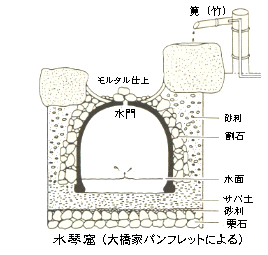|
During the final years of Meiji period (circa 1912 AD) to the beginning of Taisho period, Nihei Ohhasi built his villa with
a residential garden typical of those days. Buried in the garden is an earthen jar which produces musical sound when water
drips into it. Setup as the centerpiece of the garden, this earthen jar is called Suikinkutsu. As a result, this villa becomes
a registered cultural asset in the Kyoto city.
Before the railroad opened, the carrier of fresh fish from Setonaikai had to sail up Yodo river and land at Kusatsu near the
junction of Kamo river and Katsura river. The carrier then called the “Hashiri” (Runner) to continue the delivery directly
to Kyoto through the “Toba” highway.
The Ohhashi Family had been one of these original dealers handling fresh fish trading. But the monument of the fish market was
dedicated at the foot of the Hazukashi bridge.
The Ohhashi’s garden is called Tairyoutei (Moss cool garden). It has the same pronunciation in Japanese with (tairyou)
meaning a large catch of fish. So Mr. Ohhashi was praying for large catch of fish in naming his garden as such.
The Suikinkutsu is a musical device which was devised during the Edo Period for ornamental use in a Japanese garden.
It is a water jug with a hole at its bottom that is buried in an upside down orientation.
The water in the earth then flows naturally through the hole and accumulates at the bottom of the upside down jug.
When the water drips through the hole and collides with the surface of the accumulated water, a deep pleasing and clear
subtle sound echoes within the jar, allowing us all to enjoy.

Enlargement |
|
